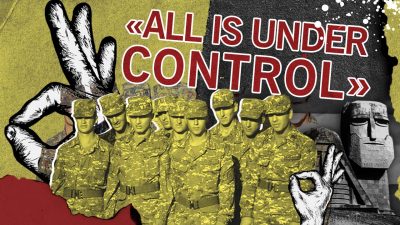Video:The US-brokered Humanitarian Ceasefire between Armenia and Azerbaijan in Nagorno-Karabakh Collapsed
Azerbaijan Is in Anger. Armenians Open Fire at Its Troops Peacefully Advancing in Nagorno-Karabakh

The US-brokered humanitarian ceasefire between Armenia and Azerbaijan in Nagorno-Karabakh collapsed immediately after its start on the morning of October 26. Clashes between the sides did not stop even for a minute and Yerevan and Baku immediately accused each other of sabotaging the peace efforts.
As of the evening of October 26, Armenian Prime Minister Nikol Pashinyan officially stated that the US-brokered ceasefire failed, while Azerbaijani President Ilham Aliyev said that “the mediators must either achieve the withdrawal of occupying forces, or move away from the path of Baku”. It seems that the estimation of the Karabakh conflict as an ‘easy case’ by US President Donald Trump did not stand the test of reality.
In a separate statement, the Azerbaijani President said that Turkish F-16 jets, which are deployed in Azerbaijan (just a few days ago the top leadership of Turkey and Azerbaijan was denying this) will be employed to protect his country in response to any act of ‘foreign aggression’. It is interesting to look how the official narrative of Azerbaijan and Turkey has been shifting from claims about Turkish non-involvement in the war to admitting the direct military participation of Ankara in the military escalation. The town of Qubadli and nearby villages were also captured by Azerbaijan as its media and diplomats were blaming Armenians for ceasefire violations.
Apparently, the coward Armenian forces violate the ceasefire regime by attacking the peacefully advancing Azerbaijani troops. The setbacks in the south of Karabakh was confirmed by the Armenian Defense Ministry, but insisted that the situation is still under full control. If this is under full control, it’s hard to imagine how the Armenian side sees the variant of the situation when all is not under control.
During the past days, the Azerbaijani-Turkish bloc continued its advance towards the Lachin corridor, a strategic area where the shortest route between Armenia and the Nagorno-Karabakh Republic is located. According to reports, after the recent gains Azerbaijani troops are now about 10-12km from the area. Azerbaijani forces are now working to secure their recent gains and establish strong points there. After this, they will likely establish fire control over the route thus undermining the Armenian ability to send supplies to Karabakh. Then, the Turkish-Azerbaijani bloc will likely push towards Stepanakert.
Armenian sources ease the retreats with regular statements about the losses of Azerbaijan accompanied by videos and photos from the ground. For example, on October 26, the Armenian Defense Ministry released a new report claiming that Azerbaijan lost 6,674 troops, 600 armoured vehicles, 6 rocket launchers, 24 planes, 16 helicopters and 220 UAVs since the start of the conflict. While the numbers provided by both sides are expectedly overestimated, the evidence demonstrates that Azerbaijani forces in fact suffered notable casualties in their advance on Karabakh. The problem for Yerevan is that Armenian forces experienced losses of similar or even higher scale.
Members of Turkish-backed militant groups that remain in Syria and are yet to move to some conflict zone to die for Erdogan’s Neo-Ottoman dream also suffer hard times. At least 78 Turkish-backed militants were killed and over 100 others were injured in a recent series of Russian airstrikes on their training camps and HQs in the Syrian region of Idlib. The main strikes targeted a former air defense base of the Syrian Army near Al-Duvayla. This area is controlled by Turkish-backed militants and the former military base itself is currently a training camp for members of Faylaq ash-Sham. Syrian sources link the increased number of Russian strikes on Turkish proxies in Syria with their deployment to the Nagorno-Karabakh combat zone to support Azerbaijan.
Russia sees the increase of the presence of radical militant groups there as an unacceptable scenario. It is likely that this lies behind the recent decrease of reports and evidence on the deployment of Turkish proxies from Syria to Karabakh. The Turkish-Azerbaijani bloc estimate the risks and prefers to avoid the situation of the involvement of some third power in the conflict on the side of the Armenians.
*
Note to readers: please click the share buttons above or below. Forward this article to your email lists. Crosspost on your blog site, internet forums. etc.
SUPPORT SOUTHFRONT:
PayPal: [email protected], http://southfront.org/donate/ or via: https://www.patreon.com/southfront

